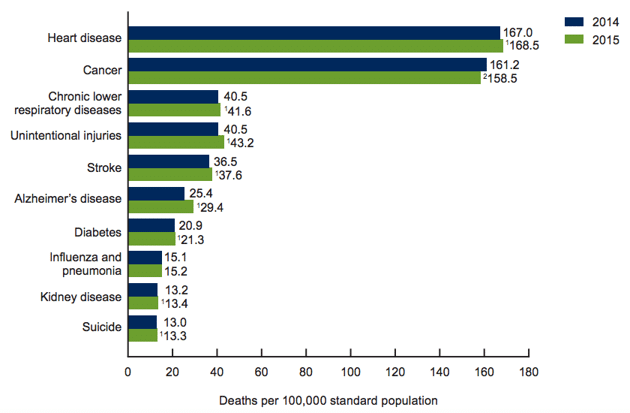
American life expectancy for 2015
Last week the CDC released mortality statistics for 2015 showing that overall life expectancy in the US dropped slightly from 78.9 to 78.8 years. As usual, women enjoy a longer life expectancy than men: men dropped from 76.5 to 76.3 years, while women dropped from 81.3 to 81.2 years.
There is a lot of hand wringing in the press over what this means. This is the first time that life expectancy has decreased in the US since 1993. We have come to expect a continuous if slow increase life expectancy as a consequence of advancing medical technology, and we take interest when this trend is reversed. I have to say, however, that I do not find this single-year, slight down tick to be very worrisome. One year is far too short a time frame to establish any trend. It would be surprising if there weren’t ever any fluctuations in the baseline trend of increasing life expectancy.
Further, the average life expectancy of the entire population, while interesting, is of limited utility. You find the real story when you dive deeper into the statistics. Even then, we need to pay more attention to long term than short term trends.
The deeper data dive
There are a couple of ways to divide up the data to get a clearer picture of what is going on, by demographics, and by disease or cause of death. By cause it is interesting to note that cancer deaths continued to decline in 2015. Every other category of cause of death went up slightly. Heart disease, stroke, and diabetes all went up, leading some to speculate that obesity is a significant cause of the decrease in life expectancy in 2015.
It is clearly the case that we are having an obesity epidemic in the US. While there are those who still doubt it, the data are unambiguous. It is more difficult to establish what the causes of increasing obesity are with the two main contenders being increased calorie consumption, and decreased physical activity. Which social factors are, in turn, leading to these two factors is even more difficult to determine, as are potential solutions.
In any case, it seems likely that increasing obesity is making itself felt in the survival statistics, but this has been a long term trend and would not necessarily explain the 2015 life expectancy down tick. The second biggest increase in terms of age-adjusted death rate was among “unintentional injuries.” This category included accidental overdoses from recreational drugs, such as opioids. There has been a recent spike in such deaths, and this is compatible with a short term change in the overall life expectancy, but it does not explain the whole picture.
Suicides also increased, and this has also been a recent trend. Some argue that this is part of the overall economic downturn. When people are out of work or economically desperate, they are more prone to drug use, to suicide, and overall do not take as good care of themselves, in addition to being subject to all of the health risks associated with poverty.
Alzheimer’s disease continued its trend of increasing the death rate. This is largely attributed to an aging population, as the risk of Alzheimer’s increases dramatically with age. Why, then, did this trend continue even as life expectancy did not increase? The increase in mortality was largely in younger populations, while the 65+ demographic did not increase.
Turning to demographics, I think the most interesting data is in regional differences. Causes of mortality are not evenly distributed, nor are the trends. In the Northeast, death from violence has been steadily decreasing, but it remains high in the Southwest. Heart disease has been decreasing overall since 1980, but not in the Appalachians.
This regional data can be useful is guiding public health measures and in identifying specific problems that need to be addressed.
Deaths rates, short term and long
It is interesting to examine this snapshot of mortality and life expectancy in the US. I do think some of the reporting has been overblown – this is just one year. It is more enlightening to examine the trends, but we definitely want to keep an eye on the numbers to see if 2015 is more of a fluke or an indicator of shifting trends. We obviously won’t know for several more years.
Meanwhile the long term trends are fairly clear. Overall life expectancy has been steadily increasing. We still don’t know how long this trend can be maintained, and if we will start running up against diminishing returns from advancing technology or even biological limits to lifespan. Death from cancer continues to steadily decrease, and this has been a persistent success story for modern medicine (again, despite ill-informed critics or those with ulterior motives).
Vascular disease (stroke, heart disease) and diabetes do appear to be dominantly behavior-driven diseases. For this reason there are dramatic regional differences in prevalence, and these are probably the diseases most modifiable by public health measures.
Diseases of poverty, including unintended injury and suicides, are an even thornier problem as they are tied to complex economic issues.
Also, it seems that degenerative neurological conditions, like Alzheimer’s disease, continue to be a major problem and deserve to be a research priority. There doesn’t appear to be any cause for the increasing Alzheimer’s incidence other than the aging population. The disease cannot be treated or cured (there are only symptomatic treatments, but none that alter the course of the disease), and we don’t know how to effectively prevent it. We simply need to continue to do research to find answers.


